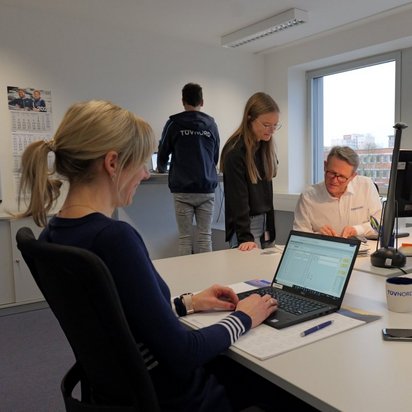When open-space offices are harmful - and when they are not
People & Empowerment: Großraumbüros sind zurecht unbeliebt: Konzentration, Kommunikation, Gesundheit – alles leidet. Das muss aber nicht so sein.

People & Empowerment: Großraumbüros sind zurecht unbeliebt: Konzentration, Kommunikation, Gesundheit – alles leidet. Das muss aber nicht so sein.

One colleague is on the phone, two others are discussing a new project - and everyone else is involuntarily listening. Few people are able to concentrate on their work under such conditions. Distracting conversations are a typical problem when working in an open-plan office, reports Katrin Müller from the Medical-Psychological Institute of TÜV NORD in Düsseldorf.
In Germany, almost 15 million people work in offices, according to a Forsa survey conducted in 2023 on behalf of the German Office and Working Environment Industry Association. Until recently, open-plan offices were the exception: before the coronavirus pandemic, only around 15 percent of office workers sat in a room with at least six people. But after the pandemic, ‘hybrid’ working became established: partly in the office, partly working from home. As a result, many companies downsized their office spaces and switched to open-plan rooms without fixed walls.
There is no standard definition of what constitutes an open-plan office, says Katrin Müller from TÜV NORD. Scientists sometimes draw the line at six, sometimes at ten or even 16 people. But regardless of which definition is used: “The verdict on open-plan offices is fairly uniform - and negative,” says the psychologist with a doctorate.

Open-plan offices are criticized
As early as 1970, the “Journal of the American Institute of Architects” reported from a survey of 18 US companies that only a few office workers wanted an open space without privacy. Today we know from numerous studies that open-plan offices are not only unpopular. Concentration, performance, communication, mood, satisfaction, health: everything suffers. The “Harvard Business Manager” wrote at the end of 2023: “The open-plan office is the worst of all office worlds.”
This is particularly true for employees who are mainly paid to think, as a German overview study in 2023 showed. In it, Marcel Hülsbeck from Munich University of Applied Sciences and Andrea Gerlitz from Witten/Herdecke University evaluated more than 400 studies on office work in companies, organizations and public administrations. The result: although management believed that open offices increase the productivity and satisfaction of the workforce, the opposite is actually the case.
A Swiss study has documented the disadvantages in detail. More than 1200 employees provided information. Here, too, it was found that the more people sat in an office, the more dissatisfied they were with the working conditions. They felt disturbed more often by other people's conversations at work and complained more often about stress and physical complaints such as tiredness or headaches.
The consequences for health were also documented in a survey of more than 2,400 office workers in Denmark. They counted 62 percent more sick days in open-plan offices with seven or more people compared to individual offices. The researchers were also able to statistically rule out the possibility that the effect was due to other differences, such as age, gender, obesity or alcohol consumption.
Concentrated work vs. human interaction
One of the stress factors of open spaces is the lack of privacy. This has a paradoxical effect, as researchers from Harvard Business School in the USA observed in 2018: Open-plan offices inhibit communication. When employees moved from small offices to open-plan offices, the number of face-to-face meetings fell by around 70 percent - instead, they sent up to 50 percent more emails and other electronic messages. As they explained, they wanted to avoid others listening in or being disturbed at work.
And rightly so, as the research shows: Having to listen in on other people's conversations is the biggest disruptive factor when concentrating on work. No partitions, table dividers or sound absorption on the ceiling can help: a room-high partition is needed. Or so-called sound masking systems: they cover up conversations with electronic background noise.
Another option is to have separate rooms for undisturbed work, meetings and telephone calls. In a field study, distractions increased after moving to an open-plan office, but satisfaction only suffered in open-plan offices that offered few quiet rooms. In surveys, only up to 30 percent of employees complained about distracting conversations from others if they had such opportunities to retreat - without this, the figure was up to 70 percent.
“Larger offices are not generally worse than smaller ones,” was one of the conclusions of the Swiss study mentioned above. It came down to the fit between the available space on the one hand and the needs and tasks of the employees on the other. For simple tasks, for example, it doesn't hurt if someone is chatting at the next table. But the more concentration is required, the more distracting conversations in the immediate vicinity become.
For open-plan offices, this means on the one hand: allowing free choice of space, for example via booking systems. This means that everyone can create the right working environment themselves - as long as there are enough places to retreat to. Secondly, every open-plan office needs a code of conduct that regulates how people work together. “The main thing is to show consideration, for example by speaking quietly or moving telephone calls to designated areas,” explains Katrin Müller from TÜV NORD.
Everyone should have a say in setting the rules. A common mistake, says the psychologist: “Not involving employees at lower hierarchical levels - or only involving them in order to convince them of something that has already been decided.”
Founded over 150 years ago, we stand for security and trust worldwide. As a knowledge company, we have our sights firmly set on the digital future. Whether engineers, IT security experts or specialists for the mobility of the future: in more than 100 countries, we ensure that our customers become even more successful in the networked world.